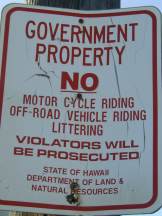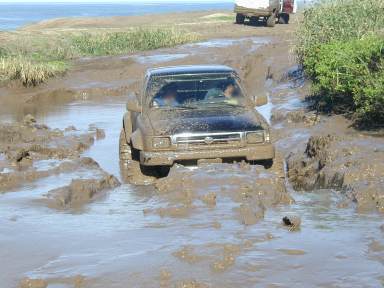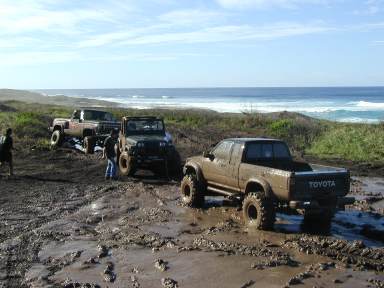DLNR‘S KAENA POINT POLICY IS MUDDIED
 |
Although recent policy changes and
enforcement actions at Kaena Point, by the
Department of Land and Natural Resources, Department of Conservation and Enforcement, are unclear,
what is clear is that they are preventing fishermen from driving into the Kaena
Point fishing area as previously allowed Both fishermen and sources at DLNR told EnviroWatch Inc. that the sudden, abrupt change in “policy” came about last October after a complaint was filed by then DLNR’S Deputy Chairperson, Janet Kawelo. |
While Kawelo and members of her family were visiting Kaena Point’s endangered species plant project area they noticed a number of vehicles, including 4-wheel drives and dirt bikes, traveling beyond the closed gate. Kawelo particularly noted that the vehicles were joy-riding and tearing up the landscape. As part of her complaint she documented the license plate numbers and sent a letter to Mr. Gary Moniz, DOCARE’s Enforcement Chief. We were informed that Kewalo specifically told Moniz that 4-wheel drive vehicles have a negative impact on the area but fishermen’s vehicles are much less serious.
| STUCK IN THE MUD ..... |  |
For unknown reasons, little or nothing was done by DOCARE to properly investigate Kawelo’s complaint. Instead, Moniz ordered his field officers to conduct a registration check and send notices of violation to the vehicle owners. The question is, was he going to prosecute the owners or the drivers of vehicles, and what was he going to rely on for evidence? We questioned Moniz about the issue but he did not respond. However, it is evident that this may be another case of unlawful arrests and citizens deprived of due process by state agencies.
There have been many other such incidents reported to DLNR, where motorcycles and other vehicles were seen tearing up the landscape, but nothing was done. However, after Kawelo made one visit to Kaena Point the entire area was closed to fishermen. This was done without any public notice or other form of advisement. At the order of Mr. Moniz and his deputies, fishermen were kicked out and the area was closed in an instant.
…AND SINKING |
 |
Members of the Oahu Shoreline Fishing Coalition (O.S.F.C), an organization formed in 1996 to prevent
the closure of Kaena Point, told us that the sudden closure of Kaena Point is a drastic
measure and is not consistent with past agreements or statements made by DLNR. Previously they had been told by DLNR
that “Kaena Point will always be open to both fishermen and their vehicles”.
In the past, when new laws were passed or current laws changed, the public was advised and given warnings or grace
periods. For example, last year
DLNR gave longline fishermen notices and a grace period when new laws banning shark fining
were passed. Why wasn’t there a grace
period or public service announcement about the closure of Kaena Point?
We are reminded of a key point regarding this situation. Ms. Janet Kawelo was not just your every day Joe Blow Citizen who just happened to be visiting Kaena Point. She was the Deputy Chairperson of DLNR, responsible for the overall management of our natural resources. One of her jobs was to protect the interest of the public by affording the public fair and clear enforcement policies as they relate to access to fishing areas as well as to other natural resource management issues. Since she specifically noted in her complaint that fishermen’s vehicles have a much less serious impact, Kawelo could have just as easily used her authority to assign additional officers to Kaena Point to take care of the area. Clearly stated rules with officers on patrol can stop joyriding while letting fishermen enter, drive at a safe speed limit to their favorite spot, and park as usual.
STUCK IN THE MIRE
Other sources wishing to remain anonymous told us that part of the blame for the abrupt change in “policy” allegedly might have been due to a cover up Moniz and his deputies initiated after their failure to address Kawelo’s complaint in a timely manner. To speed up the process, they basically demoted one of their supervisors by assigning him to Kaena Point to do an assessment and take legal actions against the vehicles Kawelo and her family reported seeing. A junior officer was then assigned to manage the demoted supervisor’s district. If Moniz’s intent were to make an assessment, why would he demote or strip a supervisor of his responsibility, or even authorize such an action? Why would he then assign a junior officer as acting supervisor in the vacant supervisory position? We posed these and other questions to Moniz hoping to get the facts but Moniz refused to respond, even after telling us by telephone, on Tuesday January 8, 2002, that he would be providing a response to our questions.
We have learned through conversations with various employees at DLNR and DOCARE some very disturbing information that fits the pattern and may explain why things don’t get done. First, we were told that the working climate at DOCARE is one of vengeance and retaliation. DOCARE’s administration used this particular incident to build a case against a couple of officers they have on a hit list of sort. While I do not have proof or the exact number, I have been informed by one of Moniz’s deputies ,there is a list of officers the administration considers “dead wood” and wants to get rid of.
Secondly, we were told Kaena Point receives little or no attention because so many officers have been assigned to Diamond Head and other popular trails to investigate T-shirt vendors. Reportedly, up to twelve officers are assigned to the Diamond Head trail twice a week in four-hour shifts. While officers watch the T-shirt vendors, 4-wheel and all-terrain vehicles continue to run amok, with little or no concern from DOCARE.
 |
The photograph on this page, showing 4-wheelers mired in mud, tell it all. Beside the numerous vehicles roaming (or not roaming) around, we saw people with unleashed dogs even though the law requires all dogs be kept on leash. The leash law is important for several reasons, one of which is to protect ground nesting Laysan albatross from the dogs. We also saw people harvesting yucca plants, loading them on their pickup truck, and driving out. We did not see a single officer the entire day we spent documenting and photographing Kaena Point last December. This may suggest that DOCARE’s actions were meant to appease Kawelo and her family, and that sound natural resources management is of little concern to the department.
CLEAR AS MUD
In order to provide the public
with a better understanding of DLNR’s policy regarding the various laws and
regulations relating to Kaena Point, EnviroWatch
Inc. sent a letter to DLNR’s Chairman, Gilbert Coloma-Agaran, then Deputy Chairwoman Janet Kawelo, and DOCARE Enforcement Chief Gary Moniz, requesting information and asking questions about the handling of Kawelo’s complaint. Unfortunately we did not receive a response. Some of the questions we asked are:
· What are the specific laws that relate to entering the Kaena Point Area? What is your Agency’s official policy as it relates to vehicles entering the area?
· Has your Department taken legal actions against the vehicles documented by Kawelo? If so how many were cited and what laws were they charged with?
· Did you or your Deputy order officers to deny entry to all vehicles?
· Will you be increasing enforcement to address the unlawful entry of Kaena Point?
· If fishermen and others drive their vehicles past the gate will your department issue notice of violations, make arrests, seize vehicles or take civil actions against them?
· Keeping in mind the fragility and sensitive nature of some of the endangered and native plant flora and fauna found in the area, why did it take a complaint from your Deputy to trigger enforcement actions?
· What are you doing to address illegal repelling in the Kaena point area where endangered and native species are found?
DLNR may not be obligated to respond to our request for information, but they surely have an obligation to properly post the area with signs and public notices that clearly state the rules and any change in policy. The main gate, though locked, doesn’t have any signs. Although there is a single sign on the up hill trail, there is a road without signs about 50 feet from the gate that allows you to drive directly into the property.
I respect and share Kawelo’s interest in endangered plants, but leaving the public to fend for itself with the threat of being arrested for not understanding DLNR’S policy is a breach of public trust that should not be tolerated. It is a difficult enough task to strike a balance between providing fishermen and other members of the public opportunities to use and enjoy the resources of this State while providing protection to endangered and threatened species and their habitat. DLNR’s actions only serve to detract and alienate fishermen, hunters and others from accepting any proposed or existing resource management effort implemented by the DLNR.
Although Kawelo initiated the events leading to the “closure” she has since left her position with DLNR, leaving the final resolution in the hands of DLNR Chairman Gilbert Coloma-Agaran.
DLNR’s refusal to respond to our questions shows a lack of respect for the public it supposedly serves. It also exposes our fishermen to legal entrapment. I urge anyone who wants to fish Kaena Point to find out what the current laws are before going in. We hope to have better news about this subject in the next issue of the Hawaii Fishing News.